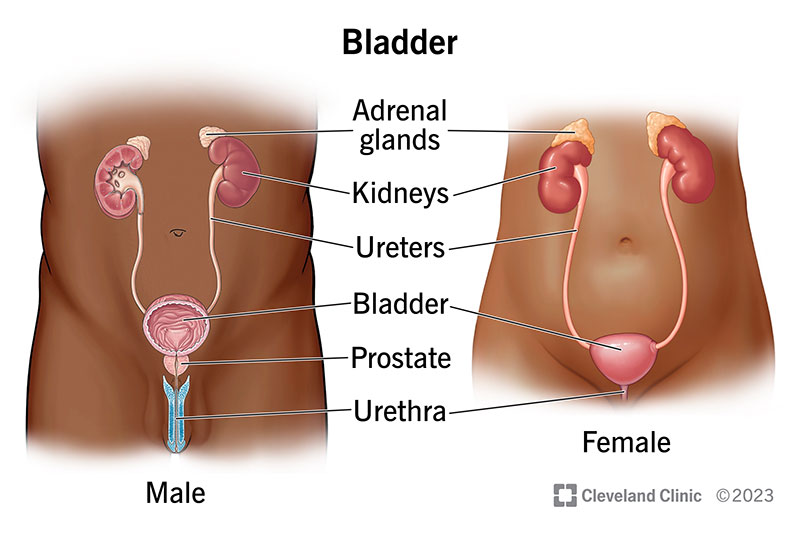The urinary bladder is a hollow, stretchy organ in the lower part of your abdomen that stores urine before it leaves your body through your urethra. Conditions that affect your bladder include incontinence, cystitis and bladder stones. They can make urinating painful, difficult or uncontrollable.
Advertisement
Cleveland Clinic is a non-profit academic medical center. Advertising on our site helps support our mission. We do not endorse non-Cleveland Clinic products or services. Policy

The urinary bladder is a hollow, spherical-shaped organ that holds urine (pee). For most people, it can hold 500-700 mL (about two cups) of pee. When you need to use the restroom, muscles in your bladder contract (tighten) and sphincter muscles in your urethra relax, allowing pee to flow out of your body.
Advertisement
Cleveland Clinic is a non-profit academic medical center. Advertising on our site helps support our mission. We do not endorse non-Cleveland Clinic products or services. Policy
The bladder is part of your urinary system.
Your bladder holds pee. Your kidneys filter your blood and remove materials such as salt, water, toxins and waste products through pee. As your bladder fills with pee, it expands like a balloon. When it fills with 200-350 mL of pee, nerves in your bladder tell your brain to use the toilet. When you pee, your bladder shrinks back down. Most people pee about 950-1,900 mL (about two quarts) each day.
The bladder is in the lower part of your abdomen (belly). Bands of tissues (ligaments) connect the bladder to other organs and your hip bone (pelvis), which keeps it in place.
In males, it rests between the pubic bone in the front and the rectum in the back.
In females, it rests in front of the vagina and uterus.
Four parts make up the structure (anatomy) of the bladder:
Advertisement
The bladder is pink or dark pink. It’s about 2 inches when empty but can stretch to 6 inches when full. It consists of three main layers:
Common conditions that affect the bladder include:
Common signs or symptoms of conditions that may affect your bladder include:
Healthcare providers use many tests to see how well your bladder works and diagnose bladder problems. Your provider may recommend:
Advertisement
Bladder treatments depend on your symptoms and a healthcare provider’s official diagnosis. Common bladder treatments may include:
It depends on what your bladder condition is. Water is important in flushing wastes and bacteria out of your urinary tract, and drinking more water can help dilute your pee. Concentrated pee can irritate your bladder and make your symptoms worse. A healthcare provider will tell you if drinking more water will help with your bladder problem and how much you should drink.
The following beverages and fluids may cause bladder irritation:
The following vitamins may help reduce sudden urges to pee or decrease your risk of incontinence:
Advertisement
It’s a good idea to talk to a provider before starting vitamin supplements to make sure they’re safe for you to take.
Your urinary bladder is a stretchy, hollow organ that stores pee until it leaves your body. Many conditions may affect your bladder, and some symptoms may be painful, inconvenient or embarrassing. If you have symptoms of a bladder condition, healthcare providers can help identify the cause and treat your symptoms.
Advertisement
Cleveland Clinic’s primary care providers offer lifelong medical care. From sinus infections and high blood pressure to preventive screening, we’re here for you.

Last reviewed on 05/24/2023.
Learn more about the Health Library and our editorial process.